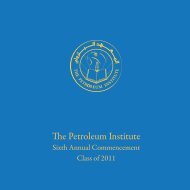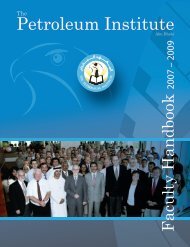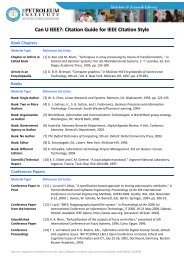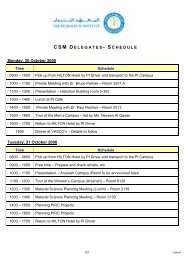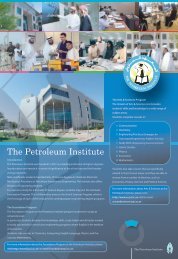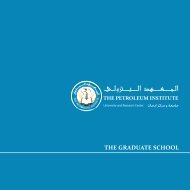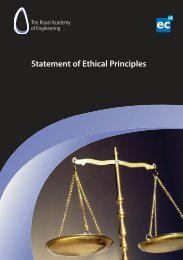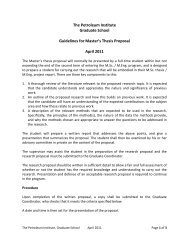Subsidence history, gravity anomalies and flexure of the United Arab ...
Subsidence history, gravity anomalies and flexure of the United Arab ...
Subsidence history, gravity anomalies and flexure of the United Arab ...
You also want an ePaper? Increase the reach of your titles
YUMPU automatically turns print PDFs into web optimized ePapers that Google loves.
Ali <strong>and</strong> Watts(Corfield et al., 2005), <strong>and</strong> dense downgoing slabs (Royden <strong>and</strong> Karner, 1984). Burgess <strong>and</strong> Moresi(1999) <strong>and</strong> Liu <strong>and</strong> Nummedal (2004), among o<strong>the</strong>rs, have suggested that dynamic topography dueto slab subduction maybe an important additional contributor to forel<strong>and</strong> basin <strong>flexure</strong>.Forel<strong>and</strong> basins comprise a distinct stratigraphic ‘architecture’, usually involving onlap as clasticclin<strong>of</strong>orm wedges move out across <strong>the</strong> basin <strong>and</strong> <strong>the</strong>n <strong>of</strong>flap as <strong>the</strong> depositional centre migrates intowards <strong>the</strong> surface <strong>and</strong> buried loads <strong>and</strong> <strong>the</strong> basin fills. Forward modelling studies have shown that<strong>the</strong> patterns <strong>of</strong> onlap <strong>and</strong> <strong>of</strong>flap are mainly controlled by <strong>the</strong> rate <strong>of</strong> migration <strong>of</strong> <strong>the</strong> thrust <strong>and</strong> foldbelt, <strong>the</strong> flexural response <strong>of</strong> <strong>the</strong> underlying basement, <strong>and</strong> <strong>the</strong> rate <strong>of</strong> sediment flux into <strong>the</strong> basin(e.g. Jordan, 1981; Flemings <strong>and</strong> Jordan, 1989; Sinclair et al., 1991).Previous studies (e.g. Robertson, 1987a; Patton <strong>and</strong> O’Connor, 1988; Boote et al., 1990; Warburton et al.,1990; Ali et al., 2008) suggest that <strong>the</strong> <strong>United</strong> <strong>Arab</strong> Emirates (UAE) forel<strong>and</strong> basin developed by flexuralloading <strong>of</strong> an underlying rifted continental margin. The rifted margin sequence (that includes Araej,Sila, Thamama <strong>and</strong> Wasia groups) comprise predominantly shelf carbonates with minor deposits <strong>of</strong>evaporites <strong>and</strong> clastics that formed during <strong>the</strong> Permian to mid-Cretaceous following break-up <strong>of</strong> <strong>the</strong><strong>Arab</strong>ian Plate <strong>and</strong> Cimmerian Terrane as well as <strong>the</strong> formation <strong>of</strong> Neo-Tethyan oceanic crust (Glennieet al., 1973; Searle, 1988a; Ruban et al., 2007) (Figures 1 <strong>and</strong> 2). The forel<strong>and</strong> basin (or Aruma basin)sequence comprises mainly deep-marine mudstones <strong>of</strong> <strong>the</strong> Fiqa <strong>and</strong> Juwaiza formations that formedduring <strong>the</strong> Late Cretaceous (Late Coniacian to Campanian) subsequent to ophiolite emplacement <strong>and</strong>thrust <strong>and</strong> fold loading in <strong>the</strong> Oman Mountains.Although <strong>the</strong>re have been a number <strong>of</strong> stratigraphic studies <strong>of</strong> <strong>the</strong> rifted margin sequences that areexposed in <strong>the</strong> eastern UAE <strong>and</strong> nor<strong>the</strong>rn Oman Mountains (e.g. Robertson, 1987b; Searle, 1988b;Rabu et al., 1993; Styles, et al., 2006; Searle, 2007), <strong>the</strong>re have been few quantitative studies <strong>of</strong> <strong>the</strong>irsubsidence <strong>and</strong> uplift <strong>history</strong>. As a result, we know little about <strong>the</strong> <strong>the</strong>rmal <strong>and</strong> mechanical properties<strong>of</strong> <strong>the</strong> Neo-Tethyan rifted margin. One problem has been that <strong>the</strong> exposures are deformed <strong>and</strong> so it isdifficult to restore <strong>the</strong>ir thickness. The best record <strong>of</strong> <strong>the</strong> subsidence <strong>and</strong> uplift <strong>history</strong>, we believe, isin <strong>the</strong> relatively undeformed rifted margin sequences that underlie <strong>the</strong> UAE forel<strong>and</strong> basin.The main aims <strong>of</strong> this paper is to use seismic reflection pr<strong>of</strong>ile, exploratory well, <strong>and</strong> Bouguer <strong>gravity</strong>anomaly data, toge<strong>the</strong>r with modern basin analysis techniques, to determine <strong>the</strong> tectonic subsidence<strong>and</strong> uplift <strong>history</strong> <strong>of</strong> <strong>the</strong> rifted margin. We <strong>the</strong>n examine its implications for <strong>the</strong> crustal structure,flexural strength <strong>and</strong> <strong>the</strong>rmal <strong>history</strong> <strong>of</strong> <strong>the</strong> UAE forel<strong>and</strong> basin.GEOLOGICAL SETTINGDuring <strong>the</strong> early Mesozoic, <strong>the</strong> UAE region was located in an equatorial setting as part <strong>of</strong> a largecarbonate platform on <strong>the</strong> rifted sou<strong>the</strong>rn continental margin <strong>of</strong> <strong>the</strong> Neo-Tethys Ocean. The earlystages <strong>of</strong> rifting were in <strong>the</strong> Mid-Permian (Glennie et al. 1973; Béchennec et al., 1990), as is evidencedby <strong>the</strong> Jabal Qamar exotic in <strong>the</strong> Dibba Zone, <strong>and</strong> Mid-Permian syn-rift (Bih Formation) in <strong>the</strong>Mus<strong>and</strong>um Peninsula, while <strong>the</strong> later stages were in <strong>the</strong> Late Triassic – Early Jurassic (Glennie etal., 1973; Searle et al., 1983; Searle, 1988b; Robertson et al., 1990; Béchennec et al., 1990). The early riftstage was dominated by continental rifting <strong>and</strong> block-faulting with more localised within-plate <strong>of</strong>faxisvolcanism, while <strong>the</strong> later stage was characterised by volcanism, tilted fault blocks, half-grabens<strong>and</strong> growth on <strong>the</strong> main border faults, leading to break-up (Robertson <strong>and</strong> Searle, 1990). Fur<strong>the</strong>r,geochemical analyses <strong>of</strong> volcanic rocks in Saih Hatat in <strong>the</strong> central Oman Mountains suggest thatoceanic crust was formed in <strong>the</strong> Late Triassic (Searle, 2007).By <strong>the</strong> end <strong>of</strong> <strong>the</strong> mid-Cretaceous, <strong>the</strong> region was a mature carbonate-dominated rifted margin inan exp<strong>and</strong>ing Neo-Tethys Ocean basin. However, at <strong>the</strong> end <strong>of</strong> <strong>the</strong> Late Cretaceous (from <strong>the</strong> LateCenomanian to <strong>the</strong> end <strong>of</strong> <strong>the</strong> Early Maastrichtian), <strong>the</strong> region was subjected to compressionaldeformation. This involved <strong>the</strong> emplacement <strong>of</strong> a number <strong>of</strong> thrusts each <strong>of</strong> which was emplacedfrom NE to SW onto <strong>the</strong> Neo-Tethyan rifted continental margin (Glennie et al., 1973; Lippard et al.,1986; Searle, 1988a). The thrusts (e.g. Figures 1 <strong>and</strong> 2) comprise <strong>the</strong> Sumeini Complex, shelf-edge<strong>and</strong> slope-carbonate sediments; <strong>the</strong> Hawasina Complex, comprising distal-slope <strong>and</strong> deep-sea Neo-Tethyan sediments; Haybi Complex, comprising Permian to Cenomanian exotic limestones (Oman18
Tectonic subsidence <strong>and</strong> uplift <strong>history</strong> <strong>of</strong> UAE forel<strong>and</strong> basinsequence from <strong>the</strong> overlying forel<strong>and</strong> basin sequence. On <strong>the</strong> Lekhwair High <strong>and</strong> in <strong>the</strong> Sharjah(UAE) area a significant amount <strong>of</strong> uplift <strong>and</strong> erosion <strong>of</strong> shelf carbonates may have been caused bya peripheral bulge that developed in response to thrust <strong>and</strong> fold loading <strong>and</strong> <strong>flexure</strong> <strong>of</strong> <strong>the</strong> shelfcarbonates (Robertson, 1987a; Patton <strong>and</strong> O’Connor, 1988).The Upper Cretaceous forel<strong>and</strong> basin was infilled by an up to 4.3 km thick Santonian − Campani<strong>and</strong>eep-marine mudstones <strong>of</strong> <strong>the</strong> Fiqa <strong>and</strong> Juwaiza formations, which rapidly increase in thicknesstowards <strong>the</strong> nor<strong>the</strong>ast (Glennie et al., 1973). Seismic sections across <strong>the</strong> forel<strong>and</strong> show <strong>the</strong> Hawasinathrust tips extending up into <strong>the</strong> Fiqa Formation (Warburton et al., 1990; Boote et al., 1990; Ali etal., 2008). The forel<strong>and</strong> sequence is, in turn, overlain by <strong>the</strong> Upper Maastrichtian to Palaeogeneconglomerates <strong>and</strong> shallow-marine limestone <strong>of</strong> <strong>the</strong> Qahlah <strong>and</strong> Simsima formations (Glennie et al.,1973; Lippard et al., 1986). The margin remained stable until post-Middle Eocene time through <strong>the</strong>deposition <strong>of</strong> <strong>the</strong> transgressive Umm Er Radhuma Formation.The UAE forel<strong>and</strong> basin region was affected by a second compressional event during <strong>the</strong> Late Eocene− Miocene when <strong>the</strong> <strong>Arab</strong>ian Plate moved nor<strong>the</strong>astward, colliding with <strong>the</strong> Eurasian Plate (Searle etal., 1983, 1988b; Searle <strong>and</strong> Ali, 2009). This event produced large-scale fold ‘culminations’ <strong>and</strong> <strong>the</strong> reactivation<strong>of</strong> deep-seated faults in <strong>the</strong> frontal fold <strong>and</strong> thrust belt <strong>and</strong> adjacent forel<strong>and</strong> basin (Booteet al., 1990; Dunne et al., 1990; Searle et al., 1990; Searle <strong>and</strong> Ali, 2009). In addition, <strong>the</strong>re was an uplift<strong>of</strong> at least 3 km along <strong>the</strong> western flank <strong>of</strong> <strong>the</strong> nor<strong>the</strong>rn Oman Mountains (Boote et al., 1990). As aresult, <strong>the</strong> sedimentary record was deeply eroded. However, <strong>the</strong> Tertiary deformation is recorded in<strong>the</strong> sequences that infill <strong>the</strong> forel<strong>and</strong> basin.The regional geological structure <strong>of</strong> <strong>the</strong> UAE forel<strong>and</strong> basin <strong>and</strong> nor<strong>the</strong>rn Oman Mountains arereflected in <strong>the</strong> Bouguer <strong>gravity</strong> anomaly map (Figure 3). The map, which was constructed from <strong>the</strong>contour data <strong>of</strong> Ravaut <strong>and</strong> Warsi (1997) in Oman <strong>and</strong> <strong>the</strong> newly acquired <strong>gravity</strong> data <strong>of</strong> Jordan(2007) <strong>and</strong> Savage (2007) in <strong>the</strong> UAE, reveals that <strong>the</strong> Oman Mountains south <strong>of</strong> <strong>the</strong> Dibba FaultZone are associated with a N-S trending Bouguer <strong>gravity</strong> anomaly high. The high correlates with<strong>the</strong> ophiolite outcrop <strong>and</strong> reaches its maximum value along <strong>the</strong> UAE coastline, suggesting that <strong>the</strong>ophiolite may extend <strong>of</strong>fshore. The high is flanked on its western edge by a N-S trending ‘low’ thatreaches its minimum value over <strong>the</strong> UAE forel<strong>and</strong> basin. We attribute this <strong>gravity</strong> high-low couple,which dominates <strong>the</strong> Bouguer anomaly map, to ophiolite loading <strong>and</strong> <strong>flexure</strong> <strong>of</strong> <strong>the</strong> rifted Neo-Tethyan margin. The couple is flanked to <strong>the</strong> west - in <strong>the</strong> <strong>Arab</strong>ian Gulf - by a small-amplitude longwavelengthhigh, which we believe delineates <strong>the</strong> present-day position <strong>of</strong> <strong>the</strong> outer bulge to thisloading <strong>and</strong> <strong>flexure</strong>.SEISMIC STRATIGRAPHY OF THE RIFTED MARGINAND OVERLYING FORELAND BASINFigure 4a shows a W-E composite regional seismic reflection pr<strong>of</strong>ile <strong>of</strong> <strong>the</strong> UAE forel<strong>and</strong> basin betweenAbu Dhabi in <strong>the</strong> west <strong>and</strong> Al-Ain in <strong>the</strong> east. The seismic data were acquired by WesternGeco <strong>and</strong>processed during <strong>the</strong> 1980s <strong>and</strong> 1990s as part <strong>of</strong> hydrocarbon exploration activities in <strong>the</strong> area. Alsoshown are <strong>the</strong> locations <strong>of</strong> three nearby exploration wells. The seismic data reveal <strong>the</strong> sedimentarystructure <strong>of</strong> <strong>the</strong> basin, but does not distinguish <strong>the</strong> syn-rift sequence from <strong>the</strong> post-rift sequence or<strong>the</strong> underlying basement. Moreover, <strong>the</strong> wells only appear to penetrate <strong>the</strong> post-rift sequence. Thecombined seismic <strong>and</strong> well data, however, allow us to sub-divide <strong>the</strong> stratigraphy <strong>of</strong> <strong>the</strong> forel<strong>and</strong>basin into three major sequences. Each sequence was delineated (Figure 4b) on <strong>the</strong> basis <strong>of</strong> its seismiccharacter, reflector terminations (e.g. onlap, toplap, <strong>and</strong> <strong>of</strong>flap) <strong>and</strong> structural style, inferred fromcontinuity <strong>and</strong> amplitude <strong>of</strong> prominent reflectors (e.g. Mitchum et al., 1977; Sheriff <strong>and</strong> Geldart,1995).Mesozoic Shelf Carbonate Sequence (Wasia Group)This sequence exhibits high-amplitude, continuous to discontinuous reflectors. In addition, <strong>the</strong> seismicpr<strong>of</strong>ile suggests <strong>the</strong> presence <strong>of</strong> fault blocks that generally step up towards <strong>the</strong> mountain front. Wedo not recognise crystalline basement, but <strong>the</strong> regional Upper Turonian Wasia-Aruma break can be21
Ali <strong>and</strong> Watts(a) West East012Two-way travel time (second)30km 204Figure 4: (a) Uninterpreted composite regional seismic reflection pr<strong>of</strong>ile across <strong>the</strong> UAE forel<strong>and</strong> basin (for location see Figure 1).(see facing page for continuation).0123424
Ali <strong>and</strong> Watts(a)150ABOUGUER GRAVITY ANOMALYA'100Gravity (mGal)500-50ObservedCalculated-Airy 'root'-1000 100 200 300 400 500Distance (km)(b)2.00.0WestW4Sea levelUAE Forel<strong>and</strong> BasinTOPOGRAPHYW3W2W1OmanMountainsThrust frontCoastlineEastGulf <strong>of</strong>OmanDepth (km)-2.0Top SimsimaTop MesozoicPlatformTop Fiqa-4.0Latitude: 23°75'NLongtitude: 52°5'E-6.00 100 200 300 400 500Distance (km)Figure 5: Bouguer <strong>gravity</strong> anomaly <strong>and</strong> topography pr<strong>of</strong>ile along Pr<strong>of</strong>ile AA’. The wells W1, W2,W3 <strong>and</strong> W4 have been projected orthogonally onto <strong>the</strong> pr<strong>of</strong>ile. (a) Bouguer <strong>gravity</strong> anomaly. Redline represents <strong>the</strong> observed. Dashed black line is <strong>the</strong> calculated <strong>gravity</strong> effect <strong>of</strong> <strong>the</strong>compensation <strong>of</strong> <strong>the</strong> topography based on <strong>the</strong> Airy model. (b) Topography. The green, purple, <strong>and</strong>red-filled dots show <strong>the</strong> depth converted Two-Way Travel Time (TWTT) picks to <strong>the</strong> top <strong>of</strong> <strong>the</strong>Simsima, Fiqa, <strong>and</strong> top <strong>of</strong> <strong>the</strong> Mesozoic platform, respectively.increase in tectonic subsidence at ca. 80 Ma is greater in well W1 than it is in well W2. This result is notunexpected because well W1 is located nearer to <strong>the</strong> ophiolite load than well W2. Well W4 (Figure 8c),however, is located fur<strong>the</strong>r away <strong>and</strong> <strong>the</strong>refore <strong>the</strong> ophiolite-induced increase in subsidence is lessapparent at this well.We compare in Figure 9 <strong>the</strong> tectonic subsidence <strong>and</strong> uplift at well W3 to predictions <strong>of</strong> a uniformstretching model (McKenzie, 1978) with different values <strong>of</strong> <strong>the</strong> amount <strong>of</strong> crust <strong>and</strong> mantle stretching, β.We use here a modified form <strong>of</strong> <strong>the</strong> McKenzie model (Cochran, 1981), which incorporates <strong>the</strong> effects<strong>of</strong> a finite duration <strong>of</strong> rifting. We assumed a rifting duration <strong>of</strong> 40 My <strong>and</strong> an initial crustal thickness,26
Tectonic subsidence <strong>and</strong> uplift <strong>history</strong> <strong>of</strong> UAE forel<strong>and</strong> basin(a)W2(b)MesozoicWELL W2Cenozoic0Oligo/Miocene(Fars Group)0JurassicRifted marginCretaceousForel<strong>and</strong>PaleoceneEoceneOphioliteemplacementDue totectonicsubsidence/upliftOligoceneMiocenePlioceneAruma PabdehTertiary-1Mus<strong>and</strong>amculminationTwo-way travel time (sec)1SimsimaUpper FiqaPaleo/Eocene(Hasa Group)UpperCretaceous(ArumaGroup)Depth (km)-2-3Total sedimentaccumulationcorrected forcompactionTectonicsubsidenceDue tosediment<strong>and</strong> waterloading2Lower FiqaMesozoicShelf CarbonatesMiddleCretaceous(Wasia Group)LateCretaceousThammamaGroup-41,1601,240UpperJurassic Sila-5160 140120 10060 40 20CMPAge (Ma)Figure 6: (a) Seismic reflection pr<strong>of</strong>ile in <strong>the</strong> immediate vicinity <strong>of</strong> <strong>the</strong> well W2 showingwell-to-seismic tie. (b) Backstripping <strong>of</strong> biostratigraphic data from well W2 showing <strong>the</strong> total sedimentaccumulation at <strong>the</strong> well toge<strong>the</strong>r with <strong>the</strong> backstripped tectonic subsidence <strong>and</strong> uplift. Note that <strong>the</strong>early part <strong>of</strong> <strong>the</strong> backstrip is concave-up <strong>and</strong> resembles <strong>the</strong> tectonic subsidence curves <strong>of</strong> riftedmargins. We interpret <strong>the</strong> inflection points at ca. 80 Ma <strong>and</strong> ca. 25 Ma as due to orogenic loading.800T c, <strong>of</strong> 31.2 km. Fur<strong>the</strong>rmore, we moved <strong>the</strong> observed curves vertically until a satisfactory fit with <strong>the</strong>modelled curves was achieved. This takes into account <strong>the</strong> fact that well W3, like <strong>the</strong> o<strong>the</strong>r wells, didnot penetrate <strong>the</strong> syn-rift sediments. The best fit was for β = 2.5, which implies a thinning <strong>of</strong> <strong>the</strong> crustfrom 31.2 km before rifting to 12.5 km after.The problem with such a large amount <strong>of</strong> thinning is that it is difficult to explain <strong>the</strong> increase that isobserved (c. 75–125 mGal, Figure 5a) in <strong>the</strong> long-wavelength, regional, Bouguer <strong>gravity</strong> anomalybetween <strong>the</strong> UAE forel<strong>and</strong> <strong>and</strong> <strong>the</strong> Gulf <strong>of</strong> Oman margin. The increase suggests that <strong>the</strong> Moho mustbe c. 5 km deeper beneath <strong>the</strong> UAE forel<strong>and</strong> than it is beneath <strong>the</strong> Oman margin. Indeed, an Airymodel in which <strong>the</strong> depth to Moho decreases from 31.2 km beneath <strong>the</strong> forel<strong>and</strong> to 24.5 km beneath<strong>the</strong> Oman margin (a difference <strong>of</strong> c. 7 km) explains <strong>the</strong> observed regional increase reasonably well(dashed line, Figure 5a). If β = 2.5, as <strong>the</strong> model in Figure 9 suggests, <strong>the</strong>n <strong>the</strong> depth-to-Moho beneath<strong>the</strong> UAE forel<strong>and</strong> would be 26.7 km (12.5 km + sediment fill). This is 2.2 km greater than beneath <strong>the</strong>Oman margin (24.5 km) <strong>and</strong> so would imply a change in <strong>the</strong> regional Bouguer anomaly between <strong>the</strong>UAE forel<strong>and</strong> <strong>and</strong> <strong>the</strong> Oman margin <strong>of</strong> 49 mGal, which is significantly less than <strong>the</strong> observed.27
Ali <strong>and</strong> WattsWe <strong>the</strong>refore need to consider o<strong>the</strong>rways <strong>of</strong> explaining <strong>the</strong> backstrippedsubsidence <strong>and</strong> uplift <strong>history</strong> that do notrequire such large amounts <strong>of</strong> thinning.One possibility is that <strong>the</strong> extensionra<strong>the</strong>r than being uniform varies withdepth. For example, if <strong>the</strong>re is moremantle extension than crustal extensionat a particular locality <strong>the</strong>n <strong>the</strong>re wouldbe less tectonic subsidence <strong>and</strong>, hence,crustal thinning.Figure 10 shows that it is possibleto explain <strong>the</strong> tectonic subsidence<strong>and</strong> uplift at well W3 with a depthdependentextension model in which<strong>the</strong> amount <strong>of</strong> crustal extension, γ, is 1.3<strong>and</strong> <strong>the</strong> amount <strong>of</strong> mantle extension, β,is 2.5. This parameter-pair explains <strong>the</strong>backstrip data well as can be seen from<strong>the</strong> sensitivity analysis in Figure 11a.Moreover, <strong>the</strong> smaller amount <strong>of</strong> crustalextension means a depth-to-Moho <strong>of</strong> 29.0km (24.0 km + sediment fill) beneath <strong>the</strong>UAE forel<strong>and</strong>. This is 4.5 km greater thanbeneath <strong>the</strong> Oman margin (24.5 km) <strong>and</strong>so would imply a change in <strong>the</strong> regionalBouguer anomaly <strong>of</strong> 100 mGal. Thisexplains <strong>the</strong> observed change well.Depth(metre)05,001,0001,5002,0002,5003,0003,500W2Porosity(%)W3 W4 W1Porosity(%)Porosity(%)Porosity(%)0 20 40 60 0 20 40 60 0 20 40 60 0 20 40 60Figure 11a also shows that it is possibleto fit <strong>the</strong> backstrip data at well W3 usingo<strong>the</strong>r combinations <strong>of</strong> crust <strong>and</strong> mantleextension parameters. For example, γ =2.3 <strong>and</strong> β = 1.5 fits <strong>the</strong> data as well as a γ <strong>of</strong>1.3 <strong>and</strong> β <strong>of</strong> 2.5. However, this parameterpair implies a shallow Moho <strong>of</strong> 27.8 km(13.5 km + sediment fill) beneath <strong>the</strong>UAE forel<strong>and</strong>. This is 3.3 km greater thanbeneath <strong>the</strong> Oman margin <strong>and</strong> so wouldimply a change in <strong>the</strong> regional Bougueranomaly <strong>of</strong> 73 mGal. This is slightlyoutside <strong>of</strong> <strong>the</strong> observed increase in <strong>the</strong>regional Bouguer <strong>gravity</strong> anomaly field.4,0004,5005,000Neutron porosityPorosity from intervaltransit timesResampled porosityFigure 7: Porosity versus depth curves derived fromsonic logs at wells W1, W2, W3 <strong>and</strong> W4. Also shownare resampled porosity <strong>and</strong> <strong>the</strong> neutron porosity in<strong>the</strong> reservoir zones. Note that <strong>the</strong> good matchbetween <strong>the</strong> sonic-derived porosity <strong>and</strong> neutronporosity.We caution, however, against <strong>the</strong> use <strong>of</strong> a depth-dependent extension model for only one margin <strong>of</strong>a conjugate margin pair. The total amount <strong>of</strong> extension in <strong>the</strong> crust <strong>and</strong> mantle across a conjugatemargin pair must be equal. O<strong>the</strong>rwise, <strong>the</strong>re would be a space problem (e.g. White <strong>and</strong> McKenzie,1988). Unfortunately, we have no information on <strong>the</strong> subsidence <strong>and</strong> uplift <strong>history</strong> <strong>of</strong> <strong>the</strong> conjugatemargin, which comprises <strong>the</strong> south-facing Neo-Tethyan rifted margin <strong>of</strong> <strong>the</strong> Central Iranian Plate<strong>and</strong> Lut Block.OROGENIC LOADINGIt is clear from <strong>the</strong> observed <strong>and</strong> calculated curves in Figures 9 <strong>and</strong> 10 that nei<strong>the</strong>r <strong>the</strong> uniform ordepth-dependent extension models are able to explain all <strong>the</strong> features <strong>of</strong> <strong>the</strong> backstrip curves <strong>and</strong> <strong>the</strong>Bouguer <strong>gravity</strong> anomaly field. In particular, <strong>the</strong> models cannot account for <strong>the</strong> excess subsidence,28
Tectonic subsidence <strong>and</strong> uplift <strong>history</strong> <strong>of</strong> UAE forel<strong>and</strong> basinDepth (km)(a)0-1-2-3-4JurassicMesozoicRifted marginCretaceousWELL W3Forel<strong>and</strong>PaleoceneCenozoicEoceneOphioliteemplacementTotal sediment accumulationcorrected for compactionTectonic<strong>Subsidence</strong>OligoceneMiocenePlioceneAruma PabdehMus<strong>and</strong>amculminationwhich begins at ca. 80–85 Ma <strong>and</strong>reaches a maximum value <strong>of</strong> c. 1 km at<strong>the</strong> present-day. Nor can <strong>the</strong>y explainall <strong>the</strong> details <strong>of</strong> <strong>the</strong> Bouguer <strong>gravity</strong>anomaly, which shows a distinctshort-wavelength <strong>gravity</strong> high-low‘couple’ that is superimposed on<strong>the</strong> regional field. The initiation <strong>of</strong><strong>the</strong> excess subsidence correspondsin time to <strong>the</strong> emplacement <strong>of</strong> <strong>the</strong>Semail Ophiolite <strong>and</strong> its associatedthrusts. We <strong>the</strong>refore attribute <strong>the</strong>excess subsidence <strong>and</strong> <strong>the</strong> Bouguer<strong>gravity</strong> anomaly couple to orogenicloading associated with <strong>flexure</strong> <strong>of</strong> <strong>the</strong>underlying rifted margin.Depth (km)-5(b)0-1-2-3160 140Jurassic120 100 80Age (Ma)MesozoicCretaceousWELL W1Forel<strong>and</strong>PaleoceneTotal sediment accumulationcorrected for compaction60 40 20CenozoicEoceneOligoceneMiocenePlioceneTectonic<strong>Subsidence</strong>0In order to test this hypo<strong>the</strong>sis, wehave carried some forward <strong>flexure</strong><strong>and</strong> <strong>gravity</strong> modelling, which takesinto account all <strong>the</strong> loads, bothsurface <strong>and</strong> subsurface, that havebeen emplaced on <strong>the</strong> rifted marginsince its formation. By comparing<strong>the</strong> calculated <strong>flexure</strong> <strong>and</strong> associated<strong>gravity</strong> <strong>anomalies</strong> due to <strong>the</strong>se loadsonto <strong>the</strong> observed base <strong>of</strong> <strong>the</strong> forel<strong>and</strong>sequence <strong>and</strong> <strong>the</strong> Bouguer <strong>gravity</strong>anomaly, we hope to constrain <strong>the</strong>effective elastic thickness, T e, whichis a proxy for <strong>the</strong> long-term strength<strong>of</strong> <strong>the</strong> rifted margin lithosphere.Surface (Topographic)Loading-4(c)0160 140 120 100 80Age (Ma)WELL W4MesozoicJurassicCretaceousRifted margin60 40 20PaleoceneCenozoicEoceneOligoceneMiocenePliocene0The present-day topography <strong>of</strong>nor<strong>the</strong>rn Oman <strong>and</strong> <strong>the</strong> eastern UAEis made up <strong>of</strong> a number <strong>of</strong> thrusts<strong>and</strong> folds, which toge<strong>the</strong>r constitutea load on <strong>the</strong> surface <strong>of</strong> <strong>the</strong> <strong>Arab</strong>ianPlate. We have investigated <strong>the</strong>flexural effects <strong>and</strong> <strong>gravity</strong> anomaly<strong>of</strong> <strong>the</strong>se loads <strong>and</strong> compared it toobservations. The comparisonsDepth (km)-1-2-3-4160 140120 100 80Age (Ma)60 40 200Figure 8: Backstripping <strong>of</strong> biostratigraphicdata from wells: (a) W3, (b)W1, <strong>and</strong> (c) W4. The concave-up riftedmargin subsidence is visible in bothwells W3 <strong>and</strong> W4. Note that <strong>the</strong> effects<strong>of</strong> orogenic loading are more clearlyseen in well W1 than in wells W3 <strong>and</strong>W4 due to its proximity to <strong>the</strong> thrustfront.29
Ali <strong>and</strong> WattsAge<strong>of</strong>riftingUNIFORM EXTENSION MODEL (WELL W3)MesozoicCenozoicTriassicJurassicCretaceousPaleoceneEoceneOligoceneMiocenePliocene0Syn-RiftPost-RiftThermal <strong>Subsidence</strong>Forel<strong>and</strong> Basin <strong>Subsidence</strong>1Depth (km)23456RiftDuration200160Tectonic <strong>Subsidence</strong>120 8040Age (Ma)β = 1.6β = 1.9β = 2.2β = 2.5β = 2.8β = 3.1β = 3.40Figure 9: Comparison <strong>of</strong> <strong>the</strong>backstrip at well W3 to <strong>the</strong>predictions <strong>of</strong> a uniform extensionmodel with crust <strong>and</strong> mantleextension, β, in <strong>the</strong> range 1.6–3.4.The calculated is based on a riftduration <strong>of</strong> 40 My <strong>and</strong> <strong>the</strong> <strong>the</strong>rmalparameters in Table 1. The best fitbetween <strong>the</strong> early part <strong>of</strong> <strong>the</strong>tectonic subsidence curve <strong>and</strong> <strong>the</strong>calculated curve is for β = 2.5.Age<strong>of</strong>riftingDEPTH-DEPENDENT EXTENSION MODEL (WELL W3)MesozoicCenozoicTriassicJurassicCretaceousPaleoceneEoceneOligoceneMiocenePliocene0Syn-RiftPost-RiftThermal <strong>Subsidence</strong>Forel<strong>and</strong> Basin <strong>Subsidence</strong>Depth (km)123456RiftDuration200Initial subsidence = 0.45 km160Thermal subsidence= 1.15 kmTectonic <strong>Subsidence</strong>γ = 1.6120 8040Age (Ma)γ = 1.0γ = 1.1γ = 1.2γ = 1.3γ = 1.4γ = 1.5γ = 1.8γ = 2.0Best-fit modelβ = 2.5γ = 1.30Figure 10: Comparison <strong>of</strong> <strong>the</strong>backstrip at well W3 to <strong>the</strong>predictions <strong>of</strong> a depth-dependentextension model with a mantleextension, β, <strong>of</strong> 2.5 <strong>and</strong> a crustextension, γ, in <strong>the</strong> range 1.0–2.0.The best fit is for γ = 1.3.30
Tectonic subsidence <strong>and</strong> uplift <strong>history</strong> <strong>of</strong> UAE forel<strong>and</strong> basin(a)0.10β = 3.5β = 1.0Root mean square0.080.060.04β = 3.0β = 2.5β = 2.0β = 1.50.02β = Mantle extension(b)-1.01.0 1.2 1.4 1.6 1.8 2.0 2.2 2.4 2.6 2.8 3.0Crustal extension (γ)(c)-1.00.01.00.01.0γ = 1.0γ = 1.1γ = 1.2Depth (km)(d)Depth (km)2.03.04.05.0-1.00.01.02.03.04.0γ = 2.5γ = 1.5γ = 1.7γ = 1.9γ = 2.0γ = 2.1γ = 2.3γ = 1.8γ = 2.0γ = 1.3γ = 1.4γ = 1.5γ = 1.6γ = 1.7γ = 1.9Mantle extension (β) = 1.5 γ = 2.75.0Mantle extension (β) = 2.5200 160 120 80 40 0 200 160 120 80 40 0Age (Ma)Age (Ma)γ = 1.7γ = 1.8γ = 1.9γ = 1.0γ = 1.1γ = 1.2γ = 1.3γ = 1.4γ = 1.5γ = 1.6γ = 2.0Depth (km)2.03.04.0Figure 11: (a) Sensitivity analysis showing <strong>the</strong>Root Mean Square (RMS) difference betweenobserved <strong>and</strong> calculated tectonic subsidence incombinations <strong>of</strong> β <strong>and</strong> γ at well W3. (b to d)Predictions <strong>of</strong> depth-dependent model with β<strong>of</strong> 1.5, 2.5 <strong>and</strong> 3.0 <strong>and</strong> γ in <strong>the</strong> range 1.0–2.7. Thered line (β <strong>of</strong> 2.5 <strong>and</strong> γ <strong>of</strong> 1.3) illustrates <strong>the</strong> bestfit model to <strong>the</strong> tectonic subsidence curve atwell W3.5.0Mantle extension (β) = 3.0200 160 120 80 40 0Age (Ma)31
Tectonic subsidence <strong>and</strong> uplift <strong>history</strong> <strong>of</strong> UAE forel<strong>and</strong> basintop <strong>of</strong> <strong>the</strong> flexed Mesozoic carbonate platform is for T ec. 5 km. This T eappears to explain both <strong>the</strong>amplitude <strong>and</strong> wavelength <strong>of</strong> <strong>the</strong> observed <strong>flexure</strong>.We note that all <strong>the</strong> calculated <strong>flexure</strong> curves in Figures 12b <strong>and</strong> 12c are <strong>of</strong>fset vertically from <strong>the</strong> top <strong>of</strong><strong>the</strong> Mesozoic platform. This <strong>of</strong>fset is attributed to <strong>the</strong> fact that <strong>the</strong> forel<strong>and</strong> basin is overfilled such that<strong>the</strong> flexural bulge is obscured beneath Abu Dhabi by approximately upto 2 km <strong>of</strong> Upper Cretaceous<strong>and</strong> younger sediment. We are not certain about <strong>the</strong> origin <strong>of</strong> <strong>the</strong> accommodation space requiredto explain this excess sediment thickness, but we believe that it might be related to <strong>the</strong> present-day,nor<strong>the</strong>rly subduction <strong>of</strong> <strong>the</strong> oceanic crust <strong>of</strong> <strong>the</strong> Gulf <strong>of</strong> Oman (Neo-Tethys Ocean) beneath Eurasia in<strong>the</strong> region <strong>of</strong> <strong>the</strong> Zagros-Makran syntaxis.While surface loading can <strong>the</strong>refore explain <strong>the</strong> shape <strong>of</strong> <strong>the</strong> observed <strong>flexure</strong>, it is unable to accountfor <strong>the</strong> Bouguer <strong>gravity</strong> anomaly couple that is observed over <strong>the</strong> Oman Mountains <strong>and</strong> flanking UAEforel<strong>and</strong>. This is well seen in Figure 12a, which shows <strong>the</strong> calculated <strong>gravity</strong> anomaly for surfaceloading <strong>of</strong> both a continuous (light grey shade) <strong>and</strong> semi-infinite (i.e. broken) (dark grey shade) elasticplate <strong>and</strong> 0 < T e< 40 km. The calculated <strong>anomalies</strong> show <strong>the</strong> same overall pattern: a low over <strong>the</strong> region<strong>of</strong> highest topography <strong>and</strong> a high that increases towards <strong>the</strong> Oman margin. None <strong>of</strong> <strong>the</strong> calculatedcurves are able to explain, however, <strong>the</strong> observed high, which reaches its maximum value <strong>of</strong> c. 100mGal east <strong>of</strong> <strong>the</strong> peak topography, or <strong>the</strong> observed low <strong>of</strong> c. 50 mGal, which reaches its minimumvalue in <strong>the</strong> vicinity <strong>of</strong> <strong>the</strong> main thrust front. The high correlates with an outcrop <strong>of</strong> ophiolite while<strong>the</strong> low correlates with <strong>the</strong> deepest part <strong>of</strong> <strong>the</strong> UAE forel<strong>and</strong> basin. We <strong>the</strong>refore attribute <strong>the</strong> highlowBouguer <strong>gravity</strong> anomaly couple to an additional, subsurface, ophiolite load <strong>and</strong> its associated<strong>flexure</strong>.Buried (Ophiolite) LoadingGeological studies suggest that Semail Ophiolite emplacement has occurred through <strong>the</strong> obduction <strong>of</strong>oceanic crust <strong>and</strong> mantle rocks onto <strong>the</strong> leading edge <strong>of</strong> <strong>the</strong> Neo-Tethyan rifted margin (e.g. Glennieet al., 1973; Tilton et al., 1981; Lippard et al., 1986; Searle <strong>and</strong> Cox, 1999; Warren et al., 2003). Theoceanic crust <strong>and</strong> mantle was probably generated above an intra-oceanic, east-dipping subductionzone by sea-floor spreading behind an isl<strong>and</strong> arc deep-sea trench system.Figure 13 shows a simple model for <strong>the</strong> <strong>flexure</strong> <strong>and</strong> <strong>gravity</strong> anomaly that would result from buried(ophiolite) loading. The load is assumed to move across <strong>the</strong> surface <strong>of</strong> <strong>the</strong> crust by thrusting. Asit moves, <strong>the</strong> load flexes <strong>the</strong> crust beneath <strong>and</strong> in front <strong>of</strong> it. We assume that <strong>the</strong> <strong>flexure</strong> fills withwater <strong>and</strong> that any sediment that displaces <strong>the</strong> water fur<strong>the</strong>r loads <strong>and</strong> flexes <strong>the</strong> crust <strong>and</strong> mantle.The corresponding <strong>gravity</strong> anomaly reflects both <strong>the</strong> loads <strong>and</strong> <strong>the</strong> resulting <strong>flexure</strong>. The calculated<strong>gravity</strong> anomaly curve shows that ophiolite loading is associated with a large-amplitude positive<strong>gravity</strong> anomaly that is flanked on one side by a small-amplitude negative anomaly. Sediment loadingreduces <strong>the</strong> amplitude <strong>of</strong> <strong>the</strong>se <strong>anomalies</strong> because it is associated with a positive anomaly over <strong>the</strong>maximum sediment thickness (sediments have a higher density than water) <strong>and</strong> a low in flankingregions.We have applied this simple buried-loading model to <strong>the</strong> seismic <strong>and</strong> <strong>gravity</strong> anomaly data acquiredalong <strong>the</strong> projected Pr<strong>of</strong>ile AA’ (Figures 1 <strong>and</strong> 3). As a first step, we estimated <strong>the</strong> magnitude <strong>of</strong> <strong>the</strong>ophiolite load by calculating <strong>the</strong> difference between <strong>the</strong> observed Bouguer anomaly <strong>and</strong> <strong>the</strong> calculatedanomaly based on surface loading anomaly. We <strong>the</strong>n used <strong>the</strong> positive part <strong>of</strong> <strong>the</strong> difference, toge<strong>the</strong>rwith <strong>the</strong> Bouguer slab formula, to compute <strong>the</strong> equivalent height <strong>of</strong> <strong>the</strong> buried load for an assumeddensity contrast between <strong>the</strong> ophiolite <strong>and</strong> <strong>the</strong> displaced material. This load was <strong>the</strong>n placed onto <strong>the</strong>surface <strong>of</strong> an elastic plate <strong>and</strong> subsequently, <strong>the</strong> <strong>flexure</strong> <strong>and</strong> <strong>gravity</strong> <strong>anomalies</strong> calculated in <strong>the</strong> sameway as for surface loading.Figures 14a to 14e show <strong>the</strong> steps in <strong>the</strong> <strong>gravity</strong> anomaly (left-h<strong>and</strong> panel) <strong>and</strong> <strong>flexure</strong> (right-h<strong>and</strong>panel) calculations assuming T e= 25 km. The o<strong>the</strong>r model parameters are as listed in Table 1. Thecontribution from crustal thinning (Figure 14d) has been calculated by applying an Airy model for <strong>the</strong>compensation <strong>of</strong> <strong>the</strong> topography. Figure 14e shows <strong>the</strong> sum <strong>of</strong> <strong>the</strong> <strong>gravity</strong> anomaly <strong>and</strong> <strong>flexure</strong> dueto surface <strong>and</strong> buried loading, sediment loading, <strong>and</strong> crustal thinning, which can be compared to <strong>the</strong>observed Bouguer anomaly <strong>and</strong> <strong>the</strong> <strong>flexure</strong> <strong>of</strong> <strong>the</strong> top <strong>of</strong> <strong>the</strong> Mesozoic platform.33
Ali <strong>and</strong> Wattskm420-2Ophiolite loadingFlexureBulgeBURIED (OPHIOLITE) LOADINGLoadWaterinfillFigure 13: Simple model for <strong>the</strong> <strong>flexure</strong> <strong>of</strong> <strong>the</strong>lithosphere due to ophiolite loading. Thecalculations are based on a semi-infinite (i.e.broken) elastic plate with a plate break located at<strong>the</strong> right-h<strong>and</strong> edge <strong>of</strong> <strong>the</strong> load. Left-h<strong>and</strong> panelshows <strong>the</strong> <strong>flexure</strong> while <strong>the</strong> right-h<strong>and</strong> panelshows <strong>the</strong> <strong>gravity</strong> anomaly. Note that sedimentloading increases <strong>the</strong> amplitude <strong>of</strong> <strong>the</strong> <strong>flexure</strong>,but decreases <strong>the</strong> amplitude <strong>of</strong> <strong>the</strong> <strong>gravity</strong>anomaly.4200Gravity Anomalykm200 km 50Sediment loadingkm 50BulgeLoadcollapseGravity (mGal)1000Ophiolite loading-2-10040 km 50-200Plate breakPlate break2002km0-2Sediment loadingBulge migrationGravity (mGal)1000-1000 km 50Sediment loadingWe found <strong>the</strong> best-fit between <strong>the</strong> observed <strong>and</strong>calculated data was for T e= 20 km <strong>and</strong> T e= 25 km,depending on whe<strong>the</strong>r <strong>the</strong> <strong>flexure</strong> or Bouguer<strong>gravity</strong> anomaly is used. These values generallyexplain both <strong>the</strong> amplitude <strong>and</strong> wavelength <strong>of</strong><strong>the</strong> <strong>flexure</strong> <strong>and</strong> <strong>the</strong> Bouguer anomaly. Smallervalues (e.g. T e= 5 km) produce too short awavelength <strong>flexure</strong> <strong>and</strong> <strong>gravity</strong> anomaly <strong>and</strong> atoo small amplitude high while higher values(e.g. T e> 35 km) produce too long a wavelength<strong>flexure</strong> <strong>and</strong> <strong>gravity</strong> anomaly <strong>and</strong> a too largeamplitude high.Gravity (mGal)-2002001000-100-2000 Sum (ophiolite + sediment loading)0 km 50DISCUSSIONSediment Thickness <strong>and</strong> Crustal StructureThe results <strong>of</strong> our <strong>the</strong>rmal <strong>and</strong> <strong>gravity</strong> studies have implications for <strong>the</strong> sediment thickness <strong>and</strong> crustalstructure <strong>of</strong> <strong>the</strong> UAE forel<strong>and</strong> basin <strong>and</strong> <strong>the</strong> Oman Mountains. Figure 15 compares, for example, <strong>the</strong>crustal structure inferred from <strong>the</strong> <strong>the</strong>rmal modelling at well W3 with <strong>the</strong> structure deduced from<strong>flexure</strong> <strong>and</strong> <strong>gravity</strong> modelling <strong>of</strong> both surface <strong>and</strong> subsurface (i.e. buried) loads.34
Ali <strong>and</strong> Watts150WestABOUGUER GRAVITY ANOMALYA'East100Plate breakGravity (mGal)500Observed-5040RMS900-10030800150mGal20700mGravity (mGal)10050010Calculated6000 10 20 30 40 50T e35 20 5-50-100010Sea level0 100 200 300 400 500Distance (km)CRUSTAL STRUCTUREW4Top flexedMesozoicplatformUAE Forel<strong>and</strong>BasinPost-riftW3W2Syn-riftCoastlineW1 OmanMountainsSubsurfaceophioliteloadGulf <strong>of</strong>OmanDepth (km)20Stretchedcrust30Moho0km 10040Figure 15: Crustal structure implied by <strong>the</strong> combined surface <strong>and</strong> buried loading model in Figure14. Note that <strong>the</strong> crust is expected to be thinner than normal beneath <strong>the</strong> UAE forel<strong>and</strong> basinbecause <strong>of</strong> rifting <strong>and</strong> thicker than normal beneath <strong>the</strong> Oman Mountains because <strong>of</strong> ophioliteloading <strong>and</strong> <strong>flexure</strong>. The inset shows <strong>the</strong> RMS difference between observed <strong>and</strong> calculated<strong>gravity</strong> <strong>anomalies</strong> (red line) <strong>and</strong> <strong>the</strong> top <strong>of</strong> <strong>the</strong> flexed Mesozoic platform (blue line).36
Ali <strong>and</strong> Watts1.0Root mean square0.80.60.4β = 1.0β = 1.5β = 2.0β = 2.5 β = 3.0β = 3.50.2β = Mantle extension0.01.0 1.2 1.4 1.6 1.8 2.0 2.2 2.4 2.6 2.8 3.0Crustal extension (γ)Figure 16: RMS difference between observed <strong>and</strong> calculated tectonic subsidence for a range <strong>of</strong> γ<strong>and</strong> β values at well W3 with initial crustal thickness <strong>of</strong> 40 km. The figure shows that <strong>the</strong> bestfitting values <strong>of</strong> <strong>the</strong> crustal extension increase from 1.3 (Figure 11) to 1.7–2.0.Figure 17 shows a compilation <strong>of</strong> T eestimates from rifted margins that were subject at some stageduring <strong>the</strong>ir evolution to a large discreet load. They include <strong>the</strong> South China Sea margin, which riftedabout 50–60 Ma <strong>and</strong> was loaded by thrusts <strong>and</strong> folds in Taiwan during <strong>the</strong> Late Miocene – EarlyPliocene (Lin <strong>and</strong> Watts, 2002), <strong>and</strong> <strong>the</strong> NE Brazil margin, which rifted ca. 120 Ma <strong>and</strong> was loaded by<strong>the</strong> Amazon fan in <strong>the</strong> Middle − Late Miocene (Rodger et al., 2006). The plot suggests a relationshipbetween T e<strong>and</strong> age since rifting. Margins that were loaded soon after <strong>the</strong> end <strong>of</strong> rifting (e.g. <strong>the</strong>South China Sea) have low values <strong>and</strong>, hence, are weak, while margins loaded over a long time after<strong>the</strong> end <strong>of</strong> rifting (e.g. NE Brazil) have high values <strong>and</strong>, hence, are strong. The Neo-Tethyan marginthat underlies <strong>the</strong> UAE forel<strong>and</strong> basin is apparently an intermediate case in which <strong>the</strong> lithosphere isnei<strong>the</strong>r weak nor strong. We note also from Figure 17 that <strong>the</strong> T evalues are quite well described by <strong>the</strong>depth to <strong>the</strong> 450 o C iso<strong>the</strong>rm based on <strong>the</strong> cooling plate model (Parsons <strong>and</strong> Sclater, 1977), suggestingthat rifted margins are weak early on (i.e. during <strong>the</strong> syn-rift) because <strong>the</strong>y are hot <strong>and</strong> streng<strong>the</strong>nlater on (i.e. during <strong>the</strong> post-rift) as <strong>the</strong>y cool.These results have consequences for <strong>the</strong> rheological properties <strong>of</strong> stretched continental lithosphere.In particular, <strong>the</strong>y suggest that like <strong>the</strong> oceanic lithosphere, continental lithosphere regains itsstrength following a heating event. Support for this suggestion has come from both Yield StrengthEnvelope (YSE) considerations (e.g. Perez-Gussinye et al., 2001) <strong>and</strong> numerical modelling (Burov <strong>and</strong>Poliakov, 2001) studies. The latter study shows that <strong>the</strong> multi-layer rheology, <strong>and</strong> hence T e, structure<strong>of</strong> continental lithosphere has a major effect on <strong>the</strong> structural styles that develop during rifting.Thermal <strong>and</strong> Maturation HistoryThe UAE forel<strong>and</strong> basin is one <strong>of</strong> a number <strong>of</strong> sub-basins on <strong>the</strong> <strong>Arab</strong>ian Plate that collectively formone <strong>of</strong> <strong>the</strong> world’s largest repositories <strong>of</strong> oil <strong>and</strong> gas resources (Alsharhan, 1989; Alsharhan <strong>and</strong> Nairn,2003). It is pertinent <strong>the</strong>refore to examine <strong>the</strong> implications <strong>of</strong> our subsidence <strong>history</strong>, <strong>gravity</strong> <strong>and</strong><strong>flexure</strong> analysis for <strong>the</strong> <strong>the</strong>rmal <strong>history</strong> <strong>of</strong> <strong>the</strong> basin.We have shown that <strong>the</strong> early, concave-up, tectonic subsidence at well W3 can be best explained bya depth-dependent extension model with γ = 1.3 <strong>and</strong> β = 2.5. This parameter pair implies a certainamount <strong>of</strong> crust <strong>and</strong> lithosphere heating at <strong>the</strong> time <strong>of</strong> rifting <strong>and</strong>, hence heat flow as <strong>the</strong> basementcools. Thermal modelling using <strong>the</strong> parameters in Table 1 shows that <strong>the</strong> heat flow varies over time,rising from 33 mW m -2 at <strong>the</strong> start <strong>of</strong> rifting, to a peak <strong>of</strong> 52 mW m -2 soon after rifting <strong>and</strong> <strong>the</strong>ndecreasing steadily to its initial value.38
Tectonic subsidence <strong>and</strong> uplift <strong>history</strong> <strong>of</strong> UAE forel<strong>and</strong> basin010South ChinaSea/TaiwanEffective elastic thickness (km)20304050Western PlatformNew Zeal<strong>and</strong>WilkesL<strong>and</strong>Nor<strong>the</strong>astBrazil/Amazon 2Neo-Tethys Ocean/OmanNor<strong>the</strong>astBrazil/Amazon 1East India/Bengal300°C450°C600°C600 25 50 75 100 125 150 175 200Age since rifting (My)Figure 17: Plot <strong>of</strong> T eversus age since <strong>the</strong> initiation <strong>of</strong> rifting for selected rifted margins, whichwere subject to unusually large loads during <strong>the</strong>ir evolution. The plot includes <strong>the</strong> NE Brazil(Rodger et al., 2006) <strong>and</strong> East India (Krishna et al., 2000) margins, which were loaded by largedeep-sea fan systems <strong>of</strong> <strong>the</strong> Amazon River <strong>and</strong> Bay <strong>of</strong> Bengal, respectively, <strong>and</strong> <strong>the</strong> South ChinaSea (Lin <strong>and</strong> Watts, 2002) <strong>and</strong> <strong>Arab</strong>ian Plate Tethyan (this paper) margins, which were loaded byorogenic loads in Taiwan <strong>and</strong> Oman, respectively. Also plotted are data from <strong>the</strong> Wilkes L<strong>and</strong>margin (Close et al., in preparation) <strong>and</strong> <strong>the</strong> Western platform, New Zeal<strong>and</strong> (Holt <strong>and</strong> Stern,1991). Thick blue lines show <strong>the</strong> predicted variation in T eduring <strong>and</strong> following rifting based on<strong>the</strong> numerical modelling <strong>of</strong> Burov <strong>and</strong> Poliakov, 2001.We have used <strong>the</strong> basement heat flow to compute <strong>the</strong> temperature in <strong>the</strong> overlying sediments, assumingthat <strong>the</strong> heat flow is <strong>the</strong> same in <strong>the</strong> cooling basement as it is in <strong>the</strong> sediments. The results suggestpresent-day (Figure 18a) temperatures <strong>of</strong> c. 130° C at <strong>the</strong> base <strong>of</strong> well W3. This agrees reasonably wellwith <strong>the</strong> observed bottom hole temperatures (150–163° C), especially when we take into account <strong>the</strong>high surface temperature (25° C) in <strong>the</strong> calculated temperatures.We know from studies in different tectonic settings (e.g. Waples, 1980; Ungerer et al., 1990; Waples,2002) that <strong>the</strong> maturation <strong>of</strong> hydrocarbons is a strong function <strong>of</strong> <strong>the</strong> time-temperature <strong>history</strong>. Wehave <strong>the</strong>refore used <strong>the</strong> temperature <strong>history</strong> in <strong>the</strong> UAE forel<strong>and</strong> to compute <strong>the</strong> Time-TemperatureIndex (TTI), which is a useful parameter with which to access <strong>the</strong> maturity <strong>of</strong> a particular sourcerock.There are two main source rocks for petroleum generation in <strong>the</strong> UAE forel<strong>and</strong>. The first is <strong>the</strong>Diyab Formation (Oxfordian − Lower Kimmeridgian), which is <strong>the</strong> <strong>of</strong>fshore equivalent <strong>of</strong> <strong>the</strong> DukhanFormation. It is <strong>the</strong> major source for <strong>the</strong> Upper Jurassic (<strong>Arab</strong> Formation) <strong>and</strong> Lower Cretaceous(Thamama Group) reservoirs. The second is <strong>the</strong> Shilaif Formation (Upper Albian − Cenomanian). Itis <strong>the</strong> main source for <strong>the</strong> Mishrif <strong>and</strong> Simsima reservoirs. O<strong>the</strong>r minor source rocks include <strong>the</strong> Jilh,Uweinat, Shu’aiba (Bab Member) <strong>and</strong> Fiqa formations (Alsharhan, 1989).Maturity estimations, based on vitrinite reflectance, indicate that <strong>the</strong> onset <strong>of</strong> oil generation in <strong>the</strong>Diyab <strong>and</strong> Dukhan formations began at 73 Ma <strong>and</strong> peaked in central, SW <strong>and</strong> NE onshore Abu Dhabi,at 56 Ma (Alsharhan, 1989; 1993a, b). In contrast, generation <strong>of</strong> oil in <strong>the</strong> Shilaif Formation started at22.5 Ma <strong>and</strong> reached maximum oil generation at 3 Ma in central <strong>and</strong> NE <strong>of</strong> Abu Dhabi (Alsharhan,1989).39
Ali <strong>and</strong> Watts(a)TEMPERATURE STRUCTURE (PRESENT-DAY)WestW4 W3 W2EastW1(c)0 0Upper TertiaryTTI - TOP FIQA (67.5 Ma)WestEastW4 W3 W2 W1Shilaif (source rock)FiqaLower TertiaryTop Wasia2Shilaif (source rock)Simsima2Diyab (source rock)Post-riftDepth (km)46Diyab (source rock)Post-riftSyn-riftFiqaTop WasiaDepth (km)46Syn-rift8Temperature0 100 200 300 400 500 600810100 200 300Age (Ma)10100 200 300Age (Ma)TIME TEMPERATURE INDEX (TTI)WestEastTTI - TOP MESOZOIC PLATFORM (82 Ma)WestEast(b)0W4 W3 W2 W1Upper Tertiary(d)0W4 W3 W2 W12Lower TertiaryShilaif (source rock)Simsima2Diyab (source rock)Post-riftDepth (km)46Diyab (source rock)Post-riftSyn-riftFiqaTop WasiaDepth (km)46Syn-rift8Time Termperature Index0 1 2 3 4810100 200 300Age (Ma)Figure 18: The <strong>the</strong>rmal <strong>history</strong> <strong>of</strong> <strong>the</strong> UAE forel<strong>and</strong> basin. The post-rift sediment isopachs arebased on <strong>the</strong> depth-converted seismic reflection pr<strong>of</strong>ile data shown in Figure 4. The syn-riftisopach <strong>and</strong> <strong>the</strong> <strong>the</strong>rmal <strong>history</strong> are based on <strong>the</strong> best-fit crust <strong>and</strong> mantle extension parametersderived from backstripping, crustal balancing <strong>and</strong> <strong>the</strong>rmal modelling at well W3 (Figure 10).O<strong>the</strong>r parameters are as listed in Table 1. (a) Temperature structure at <strong>the</strong> present-day. (b) TheTime-Temperature Index (TTI) as defined by Wapples (1980). TTI = 2 is shown as a dashed redline <strong>and</strong> corresponds to peak oil generation. (c) TTI at <strong>the</strong> top <strong>of</strong> Fiqa (ca. 67.5 Ma). (d) TTI at <strong>the</strong>top <strong>of</strong> <strong>the</strong> Mesozoic platform (ca. 82 Ma). Thick dashed grey lines show <strong>the</strong> source rocks (Diyab<strong>and</strong> Shilaif).10100 200 300Age (Ma)40
Tectonic subsidence <strong>and</strong> uplift <strong>history</strong> <strong>of</strong> UAE forel<strong>and</strong> basinFigures 18b, c <strong>and</strong> d show <strong>the</strong> TTI for <strong>the</strong> present-day, top Fiqa (ca. 67.5 Ma), <strong>and</strong> top Mesozoicplatform (ca. 82 Ma), respectively. At <strong>the</strong> present time, <strong>the</strong> Diyab <strong>and</strong> Dukhan formations are highlyto over-mature in most areas <strong>of</strong> <strong>the</strong> UAE. Whereas, <strong>the</strong> Shilaif is immature to early mature in <strong>the</strong>western onshore <strong>and</strong> <strong>of</strong>fshore areas <strong>of</strong> <strong>the</strong> UAE, except in <strong>the</strong> eastern region where rapid subsidencein <strong>the</strong> foredeep area led to deeper burial. In this area <strong>the</strong> Shilaif is mostly ei<strong>the</strong>r approaching <strong>the</strong>maximum oil generation phase or in <strong>the</strong> gas-condensate window, which is consistent with <strong>the</strong>condensate occurrences in Khusub, Margham <strong>and</strong> Sajaa fields along <strong>the</strong> western leading edge <strong>of</strong> <strong>the</strong>nor<strong>the</strong>rn Oman Mountains.Figures 18 also shows that <strong>the</strong> Upper Jurassic (i.e. middle part <strong>of</strong> <strong>the</strong> post-rift) did not reach maturityuntil ca. 67.5 Ma <strong>and</strong> <strong>the</strong>n only in <strong>the</strong> deepest part <strong>of</strong> <strong>the</strong> basin, between wells W2 <strong>and</strong> W3 <strong>and</strong> wellW1. The Upper Jurassic in <strong>the</strong> rest <strong>of</strong> <strong>the</strong> basin took longer <strong>and</strong> it is only by <strong>the</strong> present-day, that most<strong>of</strong> it became mature. This interpretation is consistent with <strong>the</strong> results <strong>of</strong> vitrinite reflectance, rockmaturity <strong>and</strong> time <strong>of</strong> oil expulsion <strong>and</strong> burial <strong>history</strong> modelling <strong>of</strong> Upper Jurassic source rocks. Forexample, modelling <strong>of</strong> source rock maturity <strong>and</strong> time <strong>of</strong> oil expulsion in nor<strong>the</strong>astern Saudi <strong>Arab</strong>iasuggests that <strong>the</strong> Upper Jurassic source rocks reached maturity in Late Cretaceous ca. 75 Ma (i.e.Campanian) (Cole et al., 1994). Fur<strong>the</strong>rmore, similar results were obtained from geo<strong>history</strong> analysisin a structurally deep part <strong>of</strong> eastern Saudi <strong>Arab</strong>ia (Pollastro, 2003). These models show that <strong>the</strong>Jurassic source rocks are presently in <strong>the</strong> late stage <strong>of</strong> oil generation.All <strong>the</strong> hydrocarbon accumulations in <strong>the</strong> UAE forel<strong>and</strong> occur in structural traps, although combinedstratigraphic <strong>and</strong> structural or stratigraphic traps exist in some areas (Alsharhan, 1989). Major trapformation <strong>and</strong> modification are a result <strong>of</strong> <strong>the</strong> two main compressional events. The first, a LateCretaceous phase (from <strong>the</strong> Late Cenomanian to <strong>the</strong> end <strong>of</strong> <strong>the</strong> Early Maastrichtian), during whichobduction-related allochthonous thrust sheets <strong>of</strong> <strong>the</strong> Oman Mountains were emplaced from NE toSW onto <strong>the</strong> <strong>Arab</strong>ian rifted margin. The second event, a Tertiary phase, is associated with <strong>the</strong> opening<strong>of</strong> <strong>the</strong> Red Sea <strong>and</strong> <strong>the</strong> collision <strong>of</strong> <strong>the</strong> <strong>Arab</strong>ian <strong>and</strong> Eurasian plates, which started during Late Eocene<strong>and</strong> continues until <strong>the</strong> present-day (Searle et al., 1983; Searle, 1988b).Our modelling results suggest that it was <strong>the</strong> first <strong>of</strong> <strong>the</strong>se orogenic events <strong>and</strong> <strong>the</strong>ir accompanyingloads <strong>and</strong> <strong>flexure</strong>s that caused source rocks in <strong>the</strong> Upper Jurassic rifted margin sequence to reachmaturity by <strong>the</strong> Late Cretaceous. O<strong>the</strong>rwise, it would have taken <strong>the</strong> sequence much longer to reachmaturity with <strong>the</strong> consequence that hydrocarbons may not have been able to migrate into a suitabletrap, even by <strong>the</strong> present-day.CONCLUSIONSWe draw <strong>the</strong> following conclusions from this paper:1. Seismic reflection pr<strong>of</strong>ile <strong>and</strong> exploratory well data show that <strong>the</strong> UAE sedimentary basin can bedivided into two main sequences: (1) a lower rifted margin sequence <strong>and</strong> (2) an upper forel<strong>and</strong>basin sequence. The margin sequence comprises at least 5 km <strong>of</strong> syn-rift <strong>and</strong> post-rift sediment.The forel<strong>and</strong> basin comprises at least 3.4 km <strong>of</strong> sediment. This yields a total sediment thickness <strong>of</strong>at least 8.4 km.2. Backstripping <strong>of</strong> biostratigraphic data from four exploration wells suggest that <strong>the</strong> transition froman extensional rifted margin to a compressional forel<strong>and</strong> basin occurred ca. 80 Ma, which is within<strong>the</strong> range for <strong>the</strong> emplacement <strong>of</strong> <strong>the</strong> Semail Ophiolite.3. The tectonic subsidence prior to 80 Ma is attributed to <strong>the</strong>rmal contraction following heating <strong>and</strong>thinning <strong>of</strong> <strong>the</strong> crust at <strong>the</strong> time <strong>of</strong> rifting. The backstrip curves <strong>and</strong> <strong>the</strong> regional Bouguer <strong>gravity</strong>field are consistent with a model in which <strong>the</strong> margin developed by non-uniform depth extension<strong>and</strong> <strong>the</strong> mantle was extended by a greater amount than <strong>the</strong> crust.4. The tectonic subsidence after 80 Ma is too large to be explained by a <strong>the</strong>rmal contraction model.Gravity <strong>and</strong> <strong>flexure</strong> modelling suggest that <strong>the</strong> excess subsidence is caused by surface <strong>and</strong>subsurface ophiolite loading <strong>of</strong> a lithosphere with an effective elastic thickness (T e) in <strong>the</strong> range <strong>of</strong>20–25 km.5. This T eis similar to what would be expected if <strong>the</strong> rifted margin sequences loaded a lithospherethat increases its strength following heating at <strong>the</strong> time <strong>of</strong> rifting.41
Ali <strong>and</strong> Watts6. Thermal modelling suggests that Upper Jurassic post-rift source rocks would not normally beexpected to reach maturity until <strong>the</strong> present-day. However, ophiolite loading <strong>and</strong> <strong>flexure</strong> increased<strong>the</strong> tectonic subsidence <strong>of</strong> <strong>the</strong> margin such that Upper Jurassic source rocks in <strong>the</strong> deepest part <strong>of</strong><strong>the</strong> UAE forel<strong>and</strong> basin could have become mature as early as Upper Cretaceous.ACKNOWLEDGEMENTSWe are grateful to The Petroleum Institute, Abu Dhabi, for its sponsorship <strong>of</strong> this project <strong>and</strong> ADNOCfor <strong>the</strong> provision <strong>of</strong> <strong>the</strong> seismic reflection pr<strong>of</strong>ile <strong>and</strong> well data used in this study, Tom Jordan <strong>and</strong>Melanie Savage for <strong>the</strong>ir help in acquiring <strong>gravity</strong> data in <strong>the</strong> field, <strong>and</strong> Mike Searle for manystimulating discussions on <strong>the</strong> tectonic evolution <strong>of</strong> <strong>the</strong> Oman Mountains. Two anonymous reviewersgreatly improved <strong>the</strong> manuscript. The final design <strong>of</strong> <strong>the</strong> paper by Arnold Egdane is appreciated.REFERENCESAli, M.Y., M. Sirat <strong>and</strong> J. Small 2008. Geophysical investigation <strong>of</strong> Al Jaww plain, eastern Abu Dhabi: Implications for structure<strong>and</strong> evolution <strong>of</strong> <strong>the</strong> frontal fold belts <strong>of</strong> Oman Mountains. Geo<strong>Arab</strong>ia, v. 13, no. 2, p. 91-118.Al-Damegh, K., E. S<strong>and</strong>vol <strong>and</strong> M. Barazangi 2005. Crustal structure <strong>of</strong> <strong>the</strong> <strong>Arab</strong>ian Plate: New constraints from <strong>the</strong> analysis <strong>of</strong>teleseismic receiver functions. Earth <strong>and</strong> Planetary Sciences Letters, v. 231, p. 177-196.Al-Lazki, A.I., D. Seber, E. S<strong>and</strong>vol <strong>and</strong> M. Barazangi 2002. A crustal transect across <strong>the</strong> Oman Mountains on <strong>the</strong> eastern margin<strong>of</strong> <strong>Arab</strong>ia. Geo<strong>Arab</strong>ia, v. 7, no. 1, p. 47-78.Alsharhan, A.S. 1989. Petroleum geology <strong>of</strong> <strong>the</strong> <strong>United</strong> <strong>Arab</strong> Emirates. Journal <strong>of</strong> Petroleum Geology, v. 12, p. 253-288.Alsharhan, A.S. 1993a. Asab field-<strong>United</strong> <strong>Arab</strong> Emirates Rub Al Khali Basin Abu Dhabi. In, N.H. Foster <strong>and</strong> E.A. Beaumont(Eds.), Structural Traps VIII. Americal Association <strong>of</strong> Petroleum Geologists, Treatise <strong>of</strong> Petroleum Geology, Atlas <strong>of</strong> Oil <strong>and</strong>Gas Fields, p. 69-98.Alsharhan, A.S. 1993b. Bu Hasa field-<strong>United</strong> <strong>Arab</strong> Emirates Rub Al Khali Basin Abu Dhabi. In, N.H. Foster <strong>and</strong> E.A. Beaumont(Eds.), Structural Traps VIII. American Association <strong>of</strong> Petroleum Geologists, Treatise <strong>of</strong> Petroleum Geology, Atlas <strong>of</strong> Oil<strong>and</strong> Gas Fields, p. 99-127.Alsharhan, A.S. <strong>and</strong> A.E.M. Nair 2003. Sedimentary basins <strong>and</strong> petroleum geology <strong>of</strong> <strong>the</strong> Middle East. Elsevier, p. 575-597.Béchennec, F., J. LeMetour, D. Rabu, C.H. Bourdillon-de-Grissac, P. DeWever, M. Beurrier <strong>and</strong> M. Villey 1990. The Hawasinanappes: Stratigraphy, palaeogeography <strong>and</strong> structural evolution <strong>of</strong> a fragment <strong>of</strong> <strong>the</strong> south Tethyan passive continentalmargin. In, A.F.H. Robertson, M.P. Searle <strong>and</strong> A.C. Ries (Eds.), The Geology <strong>and</strong> Tectonics <strong>of</strong> <strong>the</strong> Oman Region. GeologicalSociety <strong>of</strong> London, Special Publication no. 49, p. 213-223.Boote, D.R.D., D. Mou <strong>and</strong> R.I. Waite 1990. Structural evolution <strong>of</strong> <strong>the</strong> Suneinah Forel<strong>and</strong>, Central Oman Mountains. In, A.H.F.Robertson, M.P. Searle <strong>and</strong> A.C. Ries (Eds.), The Geology <strong>and</strong> Tectonics <strong>of</strong> <strong>the</strong> Oman Region. Geological Society <strong>of</strong> London,Special Publication no. 49, p. 397-418.British Oceanographic Data Centre 2003. The GEBCO Digital Atlas, Centenary Edition (CD-ROM), Liverpool.Burgess, P.M. <strong>and</strong> L.N. Moresi 1999. Modelling rates <strong>and</strong> distribution <strong>of</strong> subsidence due to dynamic topography over subductingslabs: Is it possible to identify dynamic topography from ancient strata? Basin Research, v. 11, p. 305-314.Burov, E. <strong>and</strong> A. Poliakov 2001. Erosion <strong>and</strong> rheology controls on synrift <strong>and</strong> postrift evolution: Verifying old <strong>and</strong> new ideasusing a fully coupled numerical model. Journal <strong>of</strong> Geophysical Research, v. 106, p. 16,461-416,481.Cochran, J.R. 1981. Simple models <strong>of</strong> diffuse extension <strong>and</strong> <strong>the</strong> pre-seafloor spreading development <strong>of</strong> <strong>the</strong> continental margin<strong>of</strong> <strong>the</strong> northwestern Gulf <strong>of</strong> Alden. Proceedings <strong>of</strong> <strong>the</strong> 26th International Congress Symposium on Continental Margins,Oceanologica Acta, p. 154-165.Cole, G.A., M.J. Carrigan, H.H. Colling, H.I. Halpern, M.R. Khadhrawi <strong>and</strong> P.J. Jones 1994. Organic geochemistry <strong>of</strong> <strong>the</strong> <strong>of</strong> <strong>the</strong>Jurassic petroleum system in Eastern Saudi <strong>Arab</strong>ia. In, A.F. Embary, B. Beauchamo <strong>and</strong> D.J. Closs (Eds.), Pangea, GlobalEnvironments <strong>and</strong> Resources. Canadian Society <strong>of</strong> Petroleum Geologists, Memoir 17, p. 413-438.Corfield, R.I., A.B. Watts <strong>and</strong> M.P. Searle 2005. <strong>Subsidence</strong> <strong>of</strong> <strong>the</strong> North Indian Continental Margin, Zanskar Himalaya, NWIndia. Journal <strong>of</strong> <strong>the</strong> Geological Society <strong>of</strong> London, v. 162, p. 135-146.DeCelles, P.G. <strong>and</strong> K.A. Giles 1996. Forel<strong>and</strong> basin systems. Basin Research, v. 8, p. 105-123.Dunne, L.A., P.R. Manoogian <strong>and</strong> D.F. Pierini 1990. Structural style <strong>and</strong> domains <strong>of</strong> <strong>the</strong> nor<strong>the</strong>rn Oman Mountains (Oman <strong>and</strong><strong>United</strong> <strong>Arab</strong> Emirates). In, A.H.F. Robertson, M.P. Searle <strong>and</strong> A.C. Ries (Eds.), The Geology <strong>and</strong> Tectonics <strong>of</strong> <strong>the</strong> OmanRegion. Geological Society <strong>of</strong> London, Special Publication no. 49, p. 375-386.Flemings, P.B. <strong>and</strong> T.E. Jordan 1989. A syn<strong>the</strong>tic stratigraphic model <strong>of</strong> forel<strong>and</strong> basin development. Journal <strong>of</strong> GeophysicalResearch, v. 94, p. 3851-3866.Glennie, K.W., M.G.A. Boeuf, M.W. Hughes Clark, M. Moody-Stuart, M.F. Pilaar <strong>and</strong> B.M. Reinhardt 1973. Late Cretaceousnappes in <strong>the</strong> Oman Mountains <strong>and</strong> <strong>the</strong>ir geological evolution. American Association <strong>of</strong> Petroleum Geologists Bulletin, v.57, p. 5-27.Hansen, S.E., A.J. Rodgers, S.Y. Schwartz <strong>and</strong> A.M.S. Al-Amri 2007. Imaging rupted lithosphere beneath <strong>the</strong> Red Sea <strong>and</strong><strong>Arab</strong>ian Peninsula. Earth <strong>and</strong> Planetary Sciences Letters, v. 259, p. 256-265.Holt, W.E. <strong>and</strong> T.A. Stern 1991. Sediment loading on <strong>the</strong> western platform <strong>of</strong> <strong>the</strong> New Zeal<strong>and</strong> continent: Implications for <strong>the</strong>strength <strong>of</strong> a continental margin. Earth <strong>and</strong> Planetary Sciences Letters, v. 107, p. 523-538.Issler, D.R. 1992. A new approach to shale compaction <strong>and</strong> stratigraphic restoration, Beaufort-Mackenzie Basin <strong>and</strong> MackenzieCorridor, nor<strong>the</strong>rn Canada. American Association <strong>of</strong> Petroleum Geologists Bulletin, v. 76, p. 1170-1189.Jordan, T. 2007. Gravity <strong>anomalies</strong> <strong>and</strong> <strong>flexure</strong> <strong>of</strong> <strong>the</strong> West Oman Forel<strong>and</strong> Basin: Implications for <strong>the</strong> <strong>the</strong>rmal <strong>and</strong> mechanicalevolution <strong>of</strong> continental lithosphere. DPhil, Oxford University, Oxford, UK.Jordan, T.E. 1981. Thrust loads <strong>and</strong> forel<strong>and</strong> basin evolution, Cretaceous, western <strong>United</strong> States. American Association <strong>of</strong>Petroleum Geologists Bulletin, v. 65, p. 2506-2520.42
Tectonic subsidence <strong>and</strong> uplift <strong>history</strong> <strong>of</strong> UAE forel<strong>and</strong> basinKarner, G.D. <strong>and</strong> A.B. Watts 1983. Gravity <strong>anomalies</strong> <strong>and</strong> <strong>flexure</strong> <strong>of</strong> <strong>the</strong> lithosphere at mountain ranges. Journal <strong>of</strong> GeophysicalResearch, v. 88, p. 10,449-410,477.Krishna, M.R., S. Ch<strong>and</strong> <strong>and</strong> C. Subrahmanyam 2000. Gravity <strong>anomalies</strong>, sediment loading <strong>and</strong> lithospheric <strong>flexure</strong> associatedwith <strong>the</strong> Krishna-Godavari basin, eastern continental margin <strong>of</strong> India. Earth <strong>and</strong> Planetary Sciences Letters, v. 175, p. 223-232.Lin, A.T. <strong>and</strong> A.B. Watts 2002. Origin <strong>of</strong> <strong>the</strong> West Taiwan basin by orogenic loading <strong>and</strong> <strong>flexure</strong> <strong>of</strong> a rifted continental margin.Journal <strong>of</strong> Geophysical Research, v. 107, 10.1029/2001JB000669.Lippard, S.J., A.W. Shelton <strong>and</strong> I.G. Gass 1986. The Ophiolite <strong>of</strong> Nor<strong>the</strong>rn Oman. Geological Society <strong>of</strong> London Memoir, v. 11,p. 1-178.Liu, S.-F. <strong>and</strong> D. Nummedal 2004. Late Cretaceous subsidence in Wyoming: Quantifying <strong>the</strong> dynamic component. Geology, v.32, p. 397-400.McKenzie, D.P. 1978. Some remarks on <strong>the</strong> development <strong>of</strong> sedimentary basins. Earth <strong>and</strong> Planetary Sciences Letters, v. 40, p.25-32.Miller, K.G., M.A. Kominz, J.V. Browning, J.D. Wright, G.S. Mountain, M.E. Katz, P.J. Sugarman, B.S. Cramer, N. Christie-Blick<strong>and</strong> S.F. Parker 2005. The Phanerozoic Record <strong>of</strong> Global Sea-Level Change. Science, v. 310, p. 1293-1298.Mitchum, R.M., P.R. Vail <strong>and</strong> J.B. Sangree 1977. Stratigraphic interpretation <strong>of</strong> seismic reflection patterns in depositionalsequences. In, C.E. Payton (Ed.), Seismic Stratigraphy – Applications to Hydrocarbon Exploration. American Association<strong>of</strong> Petroleum Geologists Memoir, v. 26, p. 117-133.Noweir, M.A. <strong>and</strong> A. Alsharhan 2000. Structural style <strong>and</strong> stratigraphy <strong>of</strong> <strong>the</strong> Huwayyah anticline: An example <strong>of</strong> an Al-AinTertiary fold, nor<strong>the</strong>rn Oman Mountains. Geo<strong>Arab</strong>ia, v. 5, no. 3, p. 387-402.Osman, A. 2003. Late Campanian-Maastrichtian foraminifera from <strong>the</strong> Simsima Formation on <strong>the</strong> western side <strong>of</strong> <strong>the</strong> Nor<strong>the</strong>rnOman Mountains. Cretaceous Research, v. 24, p. 391-405.Parsons, B.E. <strong>and</strong> J.G. Sclater 1977. An analysis <strong>of</strong> <strong>the</strong> variation <strong>of</strong> ocean floor bathymetry <strong>and</strong> heat flow with age. Journal <strong>of</strong>Geophysical Research, v. 82, p. 803-827.Patton, T.L. <strong>and</strong> S.J. O’Connor 1988. Cretaceous flexural <strong>history</strong> <strong>of</strong> nor<strong>the</strong>rn Oman mountain foredeep, <strong>United</strong> <strong>Arab</strong> Emirates.American Association <strong>of</strong> Petroleum Geologists Bulletin, v. 72, p. 797-809.Perez-Gussinye, M., T.J. Reston <strong>and</strong> J. Phipps-Morgan 2001. Serpentinization <strong>and</strong> magmatism during extension at non-volcanicmargins: The effect <strong>of</strong> initial lithospheric structure. In, R.C.L. Wilson, et al. (Eds.), Non-Volcanic Rifting <strong>of</strong> ContinentalMargins. Geological Society <strong>of</strong> London, p. 551-576.Pollastro, R. 2003. Total petroleum systems <strong>of</strong> <strong>the</strong> Paleozoic <strong>and</strong> Jurassic, Greater Ghawar Uplift <strong>and</strong> adjoining province <strong>of</strong>Central Saudi <strong>Arab</strong>ia <strong>and</strong> Nor<strong>the</strong>rn <strong>Arab</strong>ian-Persian Gulf. <strong>United</strong> States Geological Survey Bulletin 2202-H.Price, R.A. 1971. Gravitational sliding <strong>and</strong> <strong>the</strong> forel<strong>and</strong> thrust <strong>and</strong> fold belt <strong>of</strong> <strong>the</strong> North American Cordillera: Discussion.Geological Society <strong>of</strong> American Bulletin, v. 82, p. 1133-1138.Rabu, D., P. Nehlig, J. Roger, F. Béchennec, M. Beurrier, J. LeMetour, C.H. Bourdillon-de-Grissac, M. Tegyey. J. Chauvel, C.Cavelier, H. Al-Azri, T. Juteau, D. Janjou, B. Lemiere, M. Villey <strong>and</strong> R. Wyns 1993. Stratigraphy <strong>and</strong> structure <strong>of</strong> <strong>the</strong> OmanMountains. Bureau de Recherches Geologiques et Minieres, no. 221, Orleans, France.Raiga-Clemenceau, J., J.P. Martin <strong>and</strong> S. Nicoletis 1988. The concept <strong>of</strong> acoustic formation factor for more accurate porositydetermination from sonic transit data. Log Analyst, v. 29, p. 54-60.Ravaut, P. <strong>and</strong> W. Warsi 1997. Bouguer anomaly map <strong>of</strong> Oman. Ministry <strong>of</strong> Petroleum <strong>and</strong> Minerals, Sultanate <strong>of</strong> Oman.Robertson, A.H.F. 1987a. The transition from a passive margin to an Upper Cretaceous forel<strong>and</strong> basin related to ophioliteemplacement in <strong>the</strong> Oman Mountains. Geological Society <strong>of</strong> America Bulletin, v. 99, p. 633-653.Robertson, A.H.F. 1987b. Upper Cretaceous Muti Formation: Transition <strong>of</strong> a Mesozoic carbonate platform to a forel<strong>and</strong> basinin <strong>the</strong> Oman Mountains. Sedimentology, v. 34, p. 1123-1142.Robertson, A.H.F. <strong>and</strong> M.P. Searle 1990. The nor<strong>the</strong>rn Oman Tethyan continental margin. In, A.F.H. Robertson, M.P. Searle <strong>and</strong>A.C. Ries (Eds.), The Geology <strong>and</strong> Tectonics <strong>of</strong> <strong>the</strong> Oman Region. Geological Society <strong>of</strong> London, Special Publication no.49, p. 3-25.Robertson, A.H.F., C.D. Blome, D.W.J. Cooper, A.E.S. Kemp <strong>and</strong> M.P. Searle 1990. Evolution <strong>of</strong> <strong>the</strong> <strong>Arab</strong>ian continental marginin <strong>the</strong> Dibba Zone, Nor<strong>the</strong>rn Oman Mountains. In, A.F.H. Robertson, M.P. Searle <strong>and</strong> A.C. Ries (Eds.), The Geology <strong>and</strong>Tectonics <strong>of</strong> <strong>the</strong> Oman Region. Geological Society <strong>of</strong> London, Special Publication no. 49, p. 251-284.Rodger, M., A.B. Watts, C.J. Greenroyd, C. Peirce <strong>and</strong> R.W. Hobbs 2006. Evidence for unusually thin oceanic crust <strong>and</strong> strongmantle beneath <strong>the</strong> Amazon Fan. Geology, v. 34, p. 1081-1084.Roure, F., J. Bruneau, L. Chérel, N. Elouz, J.-L. Faure, F. Girard, A. Jardin, C. Naville, S. Rodriguez <strong>and</strong> M. Tarapoanca 2006.Deep seismic survey in <strong>the</strong> Nor<strong>the</strong>rn Emirates, Part II. Main Interpretation <strong>and</strong> Modelling Report. <strong>United</strong> <strong>Arab</strong> EmiratesMinistry <strong>of</strong> Energy, Abu Dhabi, UAE.Royden, L. <strong>and</strong> G.D. Karner 1984. Flexure <strong>of</strong> <strong>the</strong> lithosphere beneath Apennine <strong>and</strong> Carpathian foredeep basins: Evidence foran insufficient topographic load. American Association <strong>of</strong> Petroleum Geologists Bulletin, v. 68, p. 704-712.Ruban, D.A., M.I. Al-Husseini <strong>and</strong> Y. Iwasaki 2007. Review <strong>of</strong> Middle East Paleozoic plate tectonics. Geo<strong>Arab</strong>ia, v. 12, no. 4,p. 35-56.Savage, M. 2007. Gravity <strong>anomalies</strong> over <strong>the</strong> <strong>United</strong> <strong>Arab</strong> Emirates forel<strong>and</strong> <strong>and</strong> <strong>the</strong>ir tectonic implications. M.S. OxfordUniversity, Oxford, UK.Searle, M.P. 1988a. Thrust tectonics <strong>of</strong> <strong>the</strong> Dibba zone <strong>and</strong> <strong>the</strong> structural evolution <strong>of</strong> <strong>the</strong> <strong>Arab</strong>ian continental margin along <strong>the</strong>Mus<strong>and</strong>am Mountains (Oman <strong>and</strong> <strong>United</strong> <strong>Arab</strong> Emirates). Journal <strong>of</strong> <strong>the</strong> Geological Society <strong>of</strong> London, v. 145, p. 43-53.Searle, M.P. 1988b. Structure <strong>of</strong> <strong>the</strong> Mus<strong>and</strong>am culmination (Sultanate <strong>of</strong> Oman <strong>and</strong> <strong>United</strong> <strong>Arab</strong> Emirates) <strong>and</strong> <strong>the</strong> Straits <strong>of</strong>Hormuz syntaxis. Journal <strong>of</strong> <strong>the</strong> Geological Society <strong>of</strong> London, v. 145, p. 831-845.Searle, M.P. 2007. Structural geometry, style <strong>and</strong> timing <strong>of</strong> deformation in <strong>the</strong> Hawasina Window, Al Jabal al Akhdar <strong>and</strong> SaihHatat culminations, Oman Mountains. Geo<strong>Arab</strong>ia, v. 12, no. 2, p. 99-130.Searle, M.P. <strong>and</strong> M.Y. Ali 2009. Structural <strong>and</strong> tectonic evolution <strong>of</strong> Jabal Sumeini- Al Ain – Buraimi region, nor<strong>the</strong>rn Oman <strong>and</strong>eastern <strong>United</strong> <strong>Arab</strong> Emirates. Geo<strong>Arab</strong>ia, v. 14, no. 1, p. 113-140.Searle, M.P., D.J.W. Cooper <strong>and</strong> K.F. Watts 1990. Structure <strong>of</strong> <strong>the</strong> Jebel Sumeini-Jebel Ghawil area, Nor<strong>the</strong>rn Oman. In, A.H.F.Robertson, M.P. Searle <strong>and</strong> A.C. Ries (Eds.), The Geology <strong>and</strong> Tectonics <strong>of</strong> <strong>the</strong> Oman Region. Geological Society <strong>of</strong> London,Special Publication no. 49, p. 361-374.Searle, M.P. <strong>and</strong> J. Cox. 1999. Subduction zone metamorphism during formation <strong>and</strong> emplacement <strong>of</strong> <strong>the</strong> Semail ophiolite in<strong>the</strong> Oman Mountains. Geology Magazine, v. 139, p. 241-255.43
Ali <strong>and</strong> WattsSearle, M.P., N.P. James, T.J. Calon <strong>and</strong> J.D. Smewing 1983. Sedimentological <strong>and</strong> structural evolution <strong>of</strong> <strong>the</strong> <strong>Arab</strong>ian continentalmargin in <strong>the</strong> Mus<strong>and</strong>am Mountains <strong>and</strong> Dibba zone, <strong>United</strong> <strong>Arab</strong> Emirates. Geological Society <strong>of</strong> America Bulletin, v. 94,p. 1381-1400.Sheriff, R.E. <strong>and</strong> L.P. Geldart 1995. Exploration seismology. Cambridge University Press, UK, p. 349-420.Sinclair, H.D., B.J. Coakley, P.A. Allen <strong>and</strong> A.B. Watts 1991. Simulation <strong>of</strong> forel<strong>and</strong> basin stratigraphy using a diffusion model <strong>of</strong>mountain belt uplift <strong>and</strong> erosion: An example from <strong>the</strong> central Alps, Switzerl<strong>and</strong>. Tectonics, v. 10, p. 599-620.Skelton, P.W., S.C. Nolan <strong>and</strong> R.W. Scott 1990. The Maastrichtian transgression onto <strong>the</strong> northwestern flank <strong>of</strong> <strong>the</strong> Proto-OmanMountains: Sequences <strong>of</strong> rudist-bearing beach to open shelf facies. In, A.F.H. Robertson, M.P. Searle, A.C. Ries (Eds.), TheGeology <strong>and</strong> Tectonics <strong>of</strong> <strong>the</strong> Oman Region. Geological Society <strong>of</strong> London, Special Publication no. 49, p. 521-547.Steckler, M.S. <strong>and</strong> A.B. Watts 1978. <strong>Subsidence</strong> <strong>of</strong> <strong>the</strong> Atlantic-type continental margin <strong>of</strong>f New York. Earth <strong>and</strong> PlanetarySciences Letters, v. 41, p. 1-13.Styles, M.T., Ellison, R.A., S.L.B. Arkley, Q. Crowley, A. Farrant, K.M. Goodenough, J.A. Mckervey, T.C. Pharaoh, E.R. Philips,D. Sch<strong>of</strong>ield <strong>and</strong> R.J. Thomas 2006. The geology <strong>and</strong> geophysics <strong>of</strong> <strong>the</strong> <strong>United</strong> <strong>Arab</strong> Emirates. Volume 2: Geology. BritishGeological Survey.Tilton, G.R., C.A. Hopson <strong>and</strong> J.E. Wright 1981. Uranium-lead isotopic ages <strong>of</strong> <strong>the</strong> Semail ophiolite, Oman with application toTethyan ocean ridge tectonics. Journal <strong>of</strong> Geophysical Research, v. 86, p. 2763-75.Ungerer, P., J. Burrus, B. Doligez, P.Y. Chenet <strong>and</strong> F. Bessis 1990. Basin evaluation by integrated two-dimensional modelling <strong>of</strong>heat transfer, fluid flow, hydrocarbon generation, <strong>and</strong> migration. American Association <strong>of</strong> Petroleum Geologists Bulletin,v. 74, p. 309-335.Wapples, D.W. 1980. Time <strong>and</strong> temperature in petroleum formation: Application <strong>of</strong> Lapatin’s method to petroleum exploration.American Association <strong>of</strong> Petroleum Geologists Bulletin, v. 64, p. 916-926.Wapples, D.W. 2002. Maturity modelling: Thermal indicators, hydrocarbon generation, <strong>and</strong> oil cracking. In, L.B. Magoon <strong>and</strong>W.G. Dow (Eds.), The Petroleum System - From Source to Trap. American Association <strong>of</strong> Petroleum Geologists, Memoir60, p. 285-322.Warburton, J., T.J. Burnhill, R.H. Graham <strong>and</strong> K.P. Isaac 1990. The evolution <strong>of</strong> <strong>the</strong> Oman Mountains forel<strong>and</strong> basin. In, A.H.F.Robertson, M.P. Searle <strong>and</strong> A.C. Ries (Eds.), The Geology <strong>and</strong> Tectonics <strong>of</strong> <strong>the</strong> Oman Region. Geological Society <strong>of</strong> London,Special Publication no. 49, p. 419-427.Warren, C.J., R.R. Parrish, M.P. Searle <strong>and</strong> D.J. Waters 2003. Dating <strong>the</strong> subduction <strong>of</strong> <strong>the</strong> <strong>Arab</strong>ian continental margin beneath<strong>the</strong> Semail ophiolite, Oman. Geology, v. 31, p. 889-982.Watts, A.B. <strong>and</strong> W.B.F. Ryan 1976. Flexure <strong>of</strong> <strong>the</strong> lithosphere <strong>and</strong> continental margin basins. Tectonophysics, v. 36, p. 25-44.Watts, A.B. <strong>and</strong> M.S. Stecker 1979. <strong>Subsidence</strong> <strong>and</strong> eustasy at <strong>the</strong> continental margin <strong>of</strong> eastern North America. In, M. Talwani,W. Hay <strong>and</strong> W.B.F. Ryan (Eds.), Deep Drilling Results in <strong>the</strong> Atlantic Ocean: Continental Margins <strong>and</strong> Paleoenvironment.Maurice Ewing Series 3: Washington, DC, American Geophysical Union, p. 218-234.White, N. <strong>and</strong> D.P. McKenzie 1988. Formation <strong>of</strong> <strong>the</strong> “Steer’s Head” geometry <strong>of</strong> sedimentary basins by differential stretching<strong>of</strong> <strong>the</strong> crust <strong>and</strong> mantle. Geology, v. 16, p. 250-253.ABOUT THE AUTHORSMohammed Y. Ali has a degree in Exploration Geology, an MSc in Geophysics,Postgraduate Certificate in Education, <strong>and</strong> a PhD in Marine Geophysics from OxfordUniversity, UK. His current research projects are focused on exploration geophysicsin <strong>the</strong> areas <strong>of</strong> seismic processing, passive seismic, seismic stratigraphy <strong>and</strong> reservoircharacterisation <strong>and</strong> modelling. O<strong>the</strong>r research interests include basin analysis, crustalstudies, <strong>and</strong> <strong>the</strong> structure <strong>of</strong> passive margins. Mohammed joined The Petroleum Institutein 2003 as an Assistant Pr<strong>of</strong>essor <strong>of</strong> Geophysics, previous to which he had been a Researcherat Oxford University. He is a member <strong>of</strong> <strong>the</strong> SEG, EAGE, AAPG <strong>and</strong> AGU.mali@pi.ac.aeAnthony B. Watts has a BSc in Geology <strong>and</strong> Physics from University College, London, aPhD in Marine Geophysics from Durham University, <strong>and</strong> a DSc from Oxford University,UK. His current research is focused on <strong>the</strong> <strong>gravity</strong> field <strong>and</strong> its relationship to isostasy,lithospheric <strong>flexure</strong>, <strong>and</strong> <strong>the</strong> <strong>the</strong>rmal <strong>and</strong> mechanical evolution <strong>of</strong> sedimentary basins.O<strong>the</strong>r research interests include marine geology <strong>and</strong> geophysics <strong>and</strong> <strong>the</strong> deep structure<strong>of</strong> continental margins, seamounts <strong>and</strong> oceanic isl<strong>and</strong>s, <strong>and</strong> mid-ocean ridges. Anthonyjoined Oxford University in 1991 as a Pr<strong>of</strong>essor <strong>of</strong> Marine Geology <strong>and</strong> Geophysics,previous to which he had been <strong>the</strong> Arthur D. Storke Memorial Pr<strong>of</strong>essor <strong>of</strong> Geology atColumbia University, New York, USA. He is a fellow <strong>of</strong> <strong>the</strong> AGU, GSA <strong>and</strong> EGU.tony@earth.ox.ac.ukManuscript received March 30, 2008Revised June 27, 2008Accepted July 10, 2008Press version pro<strong>of</strong>read by authors January 10, 200944



